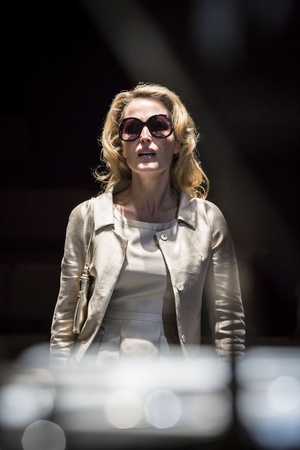Review: A STREETCAR NAMED DESIRE, National Theatre At Home

![]() A Streetcar Named Desire was the hottest ticket in town back in the summer of 2014. Six years later, it remains the fastest-selling play in the Young Vic's history. It enjoyed a New York transfer and was broadcast in cinemas around the globe thanks to National Theatre Live.
A Streetcar Named Desire was the hottest ticket in town back in the summer of 2014. Six years later, it remains the fastest-selling play in the Young Vic's history. It enjoyed a New York transfer and was broadcast in cinemas around the globe thanks to National Theatre Live.
That version is the latest instalment to be made available via NT At Home, and, although free to stream, donations are of course encouraged to help the theatre as it battles against these unprecedented circumstances.
As Blanche's fragile world crumbles, she turns to her sister Stella for solace - but her downward spiral brings her face to face with the brutal, unforgiving Stanley Kowalski. You can almost feel the Deep South heat radiating from Magda Willi's rotating IKEA-style set. At times prison-like, it is also fittingly reminiscent of a hospital ward. This compact structure serves as the battle ground for Blanche and Stanley - with Stella stuck in the middle of the war zone.
Each member of the audience was granted a slightly different perspective thanks to this imaginative configuration, which also emphasised the need for us to shift our perceptions of each character and their individual conflicts and complexities. The mildly disorientating movement also aids the slow-burning tension and reminds us that Blanche and her world are inevitably going to spin out of control.
Some filmed productions work better than others, with the size of the theatre often playing a part. The beauty of the Young Vic is its ability to reconfigure the space according to each play. The open set suggests complete exposure: nowhere to hide. With the audience seated in the round, a claustrophobic atmosphere is firmly established and sustained throughout.
This is not lost on camera, and, in many ways, our enjoyment is enhanced. Seeing the facial expressions and subtle nuances of the cast is an obvious advantage, and Stanley's violent outburst on Stella feels even more intense in close-up. While the actors are performing to a live audience, their voice projection and heightened movement only amplifies the tension on screen.
Vanessa Kirby excels as Stella and enjoys excellent, compelling chemistry with Ben Foster as Stanley. She also plays nicely off Gillian Anderson's Blanche, allowing us to believe in their relationship as sisters who are naturally close yet poles apart. Kirby expresses her character's conflict with subtlety, which only serves to accentuate Blanche and Stanley's larger-than-life personas. We enjoy the sister's initial interaction with one another before witnessing how Blanche begins to alter the home dynamic and put a strain on the marriage.
Foster is suitably boisterous and bullish as Stanley, his no-nonsense, upfront approach contrasting humorously and often uncomfortably with Blanche's superficial showmanship. Foster ensures there is depth in a character which, in the wrong hands, might be portrayed too stereotypically. We may disagree with his conduct, but we often understand his arguments.
Anderson invests her absolute all into Blanche in an electrifying and career-defining performance. With her nervous laugh and flirtatious facade, the actor excavates the many layers of the character, conveying an acute fragility that could be shattered at any moment. Blanche unravels before our eyes, but it's a slow and delicately orchestrated decline, which elicits both our sympathy and concern despite the fact that the character's delusions of grandeur grate occasionally. It's testament to Williams that we are able to view Blanche through her eyes, but also from Stanley and Stella's perspective.
Anderson also has fun with the character and embellishes any potential for comedy. This is perhaps most notable during her encounter with a young newspaper boy, with the scene prompting both laughter and sheer discomfort among the audience.
Wearing a lopsided tiara with lipstick smudged over her face, Blanche could easily enter the realm of clown or caricature. But Anderson effortlessly balances her performance, evoking our empathy for her lost loneliness as the wheels well and truly come off and her character free falls into a devastating climax. Her final confrontation with Stanley begins with such intensity before morphing into what can only be described as a haunting, albeit inevitable, conclusion.
The supporting cast each bring something to the table, with Corey Johnson's nervous, bumbling Mitch of particular note. Moments where minor characters clear away beer bottles make for seamless scene transitions, while also highlighting the mess made by both Blanche and Stanley. Everything has been carefully considered, and the camera is able to pick up on some of the quieter moments which might have escaped our attention in the theatre.
Tennessee Williams was a master of character study, and his often profound, poignant and poetic writing still captivates us today. Andrews is respectful, but - with his cast and creatives - injects a shot of adrenaline into the already beating heart of a classic. The result is an inventive, intimate and intense piece of theatre that lingers long after the curtain call. The benchmark has been set high, and it's hard to imagine a more enthralling version of the play.
A Streetcar Named Desire available to stream via National Theatre At Home until 28 May
Read our interview with Gillian Anderson
Photo credit: Johan Persson
Reader Reviews

Videos


